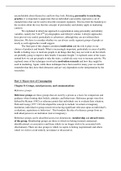Summary
Summary of Chapter 8 - 10 of Consumer Behaviour - Isabelle Szmigin & Maria Piacentini (2018): Macro-view of consumption
- Course
- Institution
- Book
Summary of Chapter 8 - 10 of Consumer Behaviour - Isabelle Szmigin & Maria Piacentini (2018): Macro-view of consumption
[Show more]




